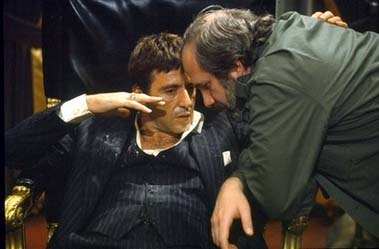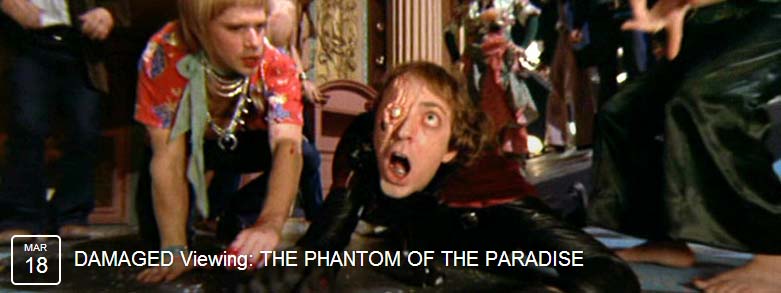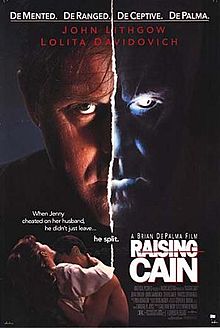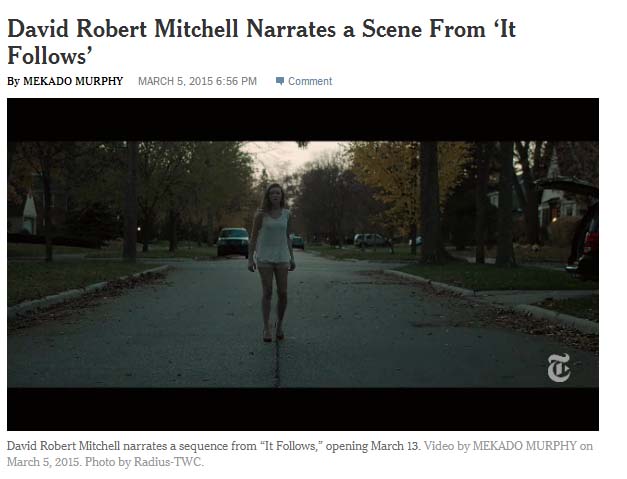"WHY DIDN'T DEPALMA'S REDACTED GET MORE RESPECT?" - LINKS TO PETER BRADSHAW REVIEW

Updated: Friday, March 20, 2015 1:07 AM CDT
Post Comment | View Comments (2) | Permalink | Share This Post
 Hello and welcome to the unofficial Brian De Palma website. Here is the latest news: |
|---|
E-mail
Geoffsongs@aol.com
-------------
Recent Headlines
a la Mod:
Listen to
Donaggio's full score
for Domino online
De Palma/Lehman
rapport at work
in Snakes
De Palma/Lehman
next novel is Terry
De Palma developing
Catch And Kill,
"a horror movie
based on real things
that have happened
in the news"
Supercut video
of De Palma's films
edited by Carl Rodrigue
Washington Post
review of Keesey book
-------------
Exclusive Passion
Interviews:
Brian De Palma
Karoline Herfurth
Leila Rozario
------------
------------
| « | March 2015 | » | ||||
| S | M | T | W | T | F | S |
| 1 | 2 | 3 | 4 | 5 | 6 | 7 |
| 8 | 9 | 10 | 11 | 12 | 13 | 14 |
| 15 | 16 | 17 | 18 | 19 | 20 | 21 |
| 22 | 23 | 24 | 25 | 26 | 27 | 28 |
| 29 | 30 | 31 | ||||
De Palma interviewed
in Paris 2002
De Palma discusses
The Black Dahlia 2006

Enthusiasms...
Alfred Hitchcock
The Master Of Suspense
Sergio Leone
and the Infield
Fly Rule
The Filmmaker Who
Came In From The Cold
Jim Emerson on
Greetings & Hi, Mom!
Scarface: Make Way
For The Bad Guy
Deborah Shelton
Official Web Site
Welcome to the
Offices of Death Records

 It's been almost a year since The Wrap reported that Chilean director Pablo Larraín would likely be directing Universal's new remake of Scarface, which will be set in Los Angeles. After David Ayers wrote an initial draft of a screenplay for the film, Donnie Brasco screenwriter Paul Attanasio was hired in 2012 to do a rewrite. Yesterday, The Hollywood Reporter's Tatiana Siegel reported that Jonathan Herman has been hired by Universal to do a new rewrite on Scarface, which will be set, this time, in Los Angeles. Siegel writes, "Herman has become a go-to writer at Universal, having penned the Straight Outta Compton draft that received the green light from the studio. He is currently in development on The Demonologist and The Birds remake at Universal.
It's been almost a year since The Wrap reported that Chilean director Pablo Larraín would likely be directing Universal's new remake of Scarface, which will be set in Los Angeles. After David Ayers wrote an initial draft of a screenplay for the film, Donnie Brasco screenwriter Paul Attanasio was hired in 2012 to do a rewrite. Yesterday, The Hollywood Reporter's Tatiana Siegel reported that Jonathan Herman has been hired by Universal to do a new rewrite on Scarface, which will be set, this time, in Los Angeles. Siegel writes, "Herman has become a go-to writer at Universal, having penned the Straight Outta Compton draft that received the green light from the studio. He is currently in development on The Demonologist and The Birds remake at Universal.

"DAMAGED Viewing, inspired by the absolute litany of Louis Fowler’s DAMAGED outings (DAMAGED Magazine, the DAMAGED Hearing radio show and the DAMAGED Viewing movie podcast), is a fun and funny live version of the absolutely insane world of trash and cult cinema, presented without pretension or prejudice.
"Hosted by Fowler and Patrick Crain, two cinema obsessives whose love of obscure film goes far beyond the realms of the silver screen and into the dumpster behind it, DV’s mission is to bring these classic (and not-so-classic) movies out of obscurity and present them, warts and all, for a public eager for something they’ve never seen before. DAMAGED Viewing explores a world of wild cinema that only the dark and dirtiest of us even knew existed."
 At Desistfilm, Victor Bruno uses the film art of Brian De Palma as an example to help explain what it is that makes a good film good. Stressing in the intro that films are not about their plots, Bruno delves into what he calls the symmetry of Brian De Palma. "How does [this symmetry] come to reality?" Bruno asks. "When do we detect it in his work? The first thing we have to understand is that it is not only visual, but also thematic and spiritual. Like any good filmmaker, he is concerned about bringing ideas into images. I will use two of his films to try to illustrate a little of this idea. The films are Obsession (1976) and Body Double (1984), made almost a decade apart but with common themes and visual logics.
At Desistfilm, Victor Bruno uses the film art of Brian De Palma as an example to help explain what it is that makes a good film good. Stressing in the intro that films are not about their plots, Bruno delves into what he calls the symmetry of Brian De Palma. "How does [this symmetry] come to reality?" Bruno asks. "When do we detect it in his work? The first thing we have to understand is that it is not only visual, but also thematic and spiritual. Like any good filmmaker, he is concerned about bringing ideas into images. I will use two of his films to try to illustrate a little of this idea. The films are Obsession (1976) and Body Double (1984), made almost a decade apart but with common themes and visual logics.A SPIRITUALIST APPROACH TO THE SYMMETRY
"Of course, the most obvious feature he presents to display this interest in halves is the split-screen. Unlike some say, the split-screen is not a 'fetishist' interest that he has; it is not a gimmick. There are, of course, things that it is: It is a heritage from Alfred Hitchcock (the viewer knows everything in advance and thus he suffers more than the unaware character of the film). But it is, also, a spiritualist approach to the symmetry. When the screen is parted in two diametric halves, De Palma is trying to put the viewer in an omniscient position, a place in which we can receive all the information the film has on hand. We assume two perspectives: the one of the victim and the one of the hero (and/or of the villain). When the screen is in a single piece, the maximum the film can present to us is a medley of feelings, emotions and interests (as presented in the long takes), but it lacks a fundamental feature in a Brian De Palma picture: organization. The greatest struggle of a DePalmian character is to understand what he is living and the situation he is in and in order to do it he has to organize the facts and the feelings he is experiencing.
"But until he gets to the organization (and it does not mean you will survive in this world), the character still have to discover what is truth and what is deception. These are the themes of Obsession and Body Double. Early on the former we get what perhaps is the best shot of the career of Brian De Palma: with the left and the right sides of the screen separated by a wall, on the former we see Cliff Robertson’s character reaching for a gun and on the latter we see John Lithgow’s character trying to get information from a little kid who may or may not know anything about the kidnapping of Robertson’s daughter and wife.
"Of course, De Palma is not Wes Anderson: the screen is not split pin-point on the middle. Of course, later in his career he would be more demanding about the way he symmetrically splits his screen (more pronouncedly in Blow Out with the split diopter). But right now it doesn’t matter—it is a split screen. We have to different actions happening in two different places. Both are acts of violence—Robertson’s mind is going to crack and he is considering to kill someone; Lithgow is making pressure on a young kid. But there is a third layer, the layer that separates truth and lie: Lithgow is not interested at all in helping his friend—the truth is that he wants to drive Cliff Robertson crazy and he wants his money. So there you have it: the borderline of reality and deception. Truth and lie. Friendship and betrayal. Good intentions and bad acts. (And it’s a brilliant use of CinemaScope, don’t you agree?)"
That is just an excerpt-- go to Desistfilm to read the whole thing.
 The March 2015 issue of EMPIRE magazine, on stands now in the U.S., includes a one-page C.V. in which John Lithgow discusses his signature roles. Under the heading, "His Biggest Challenge," is Brian De Palma's Raising Cain, with the characters listed as "Carter/Cain/Dr. Nix/Josh/Margo, deranged doctor and his brood." Of his role(s) in the film, Lithgow tells EMPIRE, "The most plot-heavy film I've been in. It was only two characters, and yet you wanted to fool people into thinking it was three or four. The rehearsal period was simply charting the crazy."
The March 2015 issue of EMPIRE magazine, on stands now in the U.S., includes a one-page C.V. in which John Lithgow discusses his signature roles. Under the heading, "His Biggest Challenge," is Brian De Palma's Raising Cain, with the characters listed as "Carter/Cain/Dr. Nix/Josh/Margo, deranged doctor and his brood." Of his role(s) in the film, Lithgow tells EMPIRE, "The most plot-heavy film I've been in. It was only two characters, and yet you wanted to fool people into thinking it was three or four. The rehearsal period was simply charting the crazy."

AVC: There’s a lot of vintage John Carpenter in this film, especially in the music and the use of space. Was he a big influence, and were there other filmmakers whose work you studied when bringing the movie to life?DRM: Of course, I totally love Carpenter—Halloween, and his version of The Thing is a favorite of mine. I’ve definitely watched his movies a million times. I’m a fan of his blocking and his staging and his compositions. For me, it wasn’t just about saying, “This particular shot is a Carpenter homage.” I’ve watched his stuff enough that’s probably going to come out in the filmmaking. But there’s a ton of other filmmakers that factored in, too. I also love Cronenberg, I’m a big De Palma fan—I think there’s probably a lot of De Palma in there as well. Hitchcock, too. Rear Window is my favorite movie of all time. I love Creature From The Black Lagoon. I could go on and on about all the people that I love. And then there are other elements of the movie that are not necessarily the horror elements. Some of the inspiration for that comes from a lot of different places, few of them having anything to do with horror.
AVC: Do you have rules about how you write teenage characters? One of the interesting things about It Follows is that it features kids who don’t talk in references or relate everything to something they’ve seen.
DRM: Yeah, there’s an avoidance of certain aspects of pop culture, but then I like to embrace other parts of it. It’s tricky, because I’ve only made these two films, but I have a million different scripts and a million different things that I want to make. The two that I’ve done have just been about teenagers, but I have stories about many different characters at many different stages of life.
It more has to do with my general belief that film doesn’t have to operate within the world we live in. The ground rules of the film world don’t have to be how we understand the world. And something doesn’t have to be fantasy to take some elements from fantasy. Movies are very much dreams, in a way, and you can use that to your advantage.
AVC: The time period of the movie is fascinatingly indeterminate. One of the girls has this mobile device, but otherwise we could be watching a movie set in 1990.
DRM: There are production design elements from the ’50s on up to modern day. A lot of it is from the ’70s and ’80s. That e-reader cell phone—or “shell phone”—you’re talking about is not a real device. It’s a ’60s shell compact that we turned into a cell phone e-reader. So I wanted modern things, but if you show a specific smartphone now, it dates it. It’s too real for the movie. It would bother me anyway. So we made one up. And all of that is really just to create the effect of a dream—to place it outside of time, and to make people wonder about where they are. Those are things that I think happen to us when we have a dream.
AVC: Plenty of people have read the “It” of It Follows as a metaphor for a sexually transmitted disease, but that doesn’t entirely scan, as you can’t get rid of an STD by sleeping with someone else.
DRM: [Laughs.] Right, exactly. I was totally aware of that connection when I wrote the script, but it wasn’t necessarily the driving force in terms of subtext. There are a lot of other aspects. I tend to shy away from explaining it, but I’m happy to have the conversation.
AVC: Of course, you don’t need to unpack your own film. That’s for us to do.
DRM: [Laughs.] But I would agree with you that even if you read it that way, it’s much more complicated than that.
AVC: You mentioned Brian De Palma earlier. He’s a director who builds his film around set pieces, and I feel as though the scary moments in It Follows are essentially set pieces, too. Did you write all of them into the script or were there any moments born when you were on location?
DRM: Oh, no, it’s all in the script. There are small elements that we worked out on set. But we didn’t have a ton of money, so it was about having a really solid plan and going in and doing everything in our power to get it done. There was very little time to change things once we got going.
So I worked those [set pieces] out in my head beforehand. Most of that stuff was probably in the first draft of the script. A few things changed. Some set pieces became smaller because of budget. There were a couple of really cool ideas from the first draft that would have been really fun to do, but we would have just needed a lot more money and people. I had a lot of ideas of ways you could use the rules of this monster to generate suspense and create some really interesting set pieces. And I only got to do a few of them in the film, really.
"This week's superb chiller It Follows (read our review) has been frequently described as a 'throwback,'" Taylor begins. "This probably has to do with the film, which concerns a teenage girl (Maika Monroe from the similarly wonderful The Guest) who is stalked by a ghoul following an untoward sexual encounter, feeling like it's from another era. The synth-heavy electronic score (check out a few cuts here) is straight out of the '80s, while other aspects feel eerie and timeless in a way that few modern day horror films do. We sat down with director David Robert Mitchell and talked about the five biggest influences on It Follows, and some are as surprising as the movie itself.
"Throughout the course of our conversation, we talked about a number of influences that come to bear on the film — from the French New Wave to the stylized camera trickery of Brian De Palma (Mitchell says he didn't tell his financiers about his intention to shoot so many extremely long takes), from the hollowed-out city of Detroit to the suburban horror of Poltergeist. But the following five influences are the most significant to Mitchell —these were the films that he first referenced and had no problem elaborating on. Some of the films' DNA is easy to spot in It Follows, while others function more as spiritual successors. But all of it enhances Mitchell's work, and it's easy to think that in a few years some young director of the next horror sensation will cite It Follows as a reference."
The five main influences on It Follows, according to the article, are Creature from the Black Lagoon, George Romero's Night of the Living Dead," John Carpenter (and Howard Hawks' The Thing from Another World), Wes Craven's Nightmare On Elm Street, and Wim Wenders' Paris, Texas.

"So this is the opening shot of the film. We’re starting with this sort of slow, kind of calm, objective shot of this middle class neighborhood. And we see this girl running in fear. We’re not really sure what it is that she’s running from, or what she’s scared of. Maybe a play on a bit of a cliché, some of this is, right down to the wardrobe is… she’s in high heels, which I’ve had some people point out, questioning, ‘does that make a lot of sense?’ And the answer is no. It’s definitely a bit of a play on the conventions of horror, all the way back to referencing women in peril, from even De Palma movies, for instance. You’ll notice throughout this sequence… we did this in… it’s in one shot. It’s playing on this idea of us being sort of colder observers of this terrible thing happening, and we’re on the outside of it."